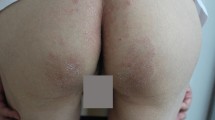Abstract
In this report, we describe the first isolation of two highly terbinafine (TRF)-resistant Trichophyton interdigitale-like strains from a Nepali patient and an Indian patient with tinea corporis in Japan. These strains (designated NUBS19006 and NUBS19007) exhibited a TRF minimal inhibitory concentration (MIC) of > 32 mg/L and contained a missense mutation (Phe397Leu) in squalene epoxidase (SQLE) gene. The internal transcribed spacer (ITS) region sequences amplified from the isolates (NUBS19006 and NUBS19007) were 99.5% identical to Japanese isolates of T. interdigitale and T. interdigitale strain CBS 428.63. The homology of region sequences were also 97.6% identical to T. mentagrophytes strain CBS 318.56. Moreover, the ITS sequences amplified from the isolates were 100% identical to highly TRF-resistant strains of T. interdigitale, which were isolated in Delhi, India, and harbored mutations in SQLE. The urease test on Christensen’s urease agar was positive for T. mentagrophytes and T. interdigitale after 7 days of incubation. On the other hand, the type strain of T. rubrum CBS 100081 T and highly TRF-resistant strains (NUBS19006 and NUBS19007) were negative on Christensen urease agar after 7 and 14 days of incubation. Moreover, NUBS19006 and NUBS19007 were also negative reaction on the hair perforation test. To avoid confusion in the taxonomy of the T. mentagrophytes/T. interdigitale complex, we suggest that the highly TRF-resistant Indian strains be considered a new species independent of T. interdigitale, according to clinical and mycological features.







Similar content being viewed by others
References
Kwon-Chung KJ, Bennett EJ. Dermatophytoses. In: Medical mycology, Philadelphia: Lea & Febiger, 1992;105–161 and 816–826.
Reiss E, Shadomy HJ, Lyon IIIGM. Dermatophytosis. In: Fundamental medical mycology, New Jersey: Wiley; 2012; 527–566.
Singh A, Masih A, Khurana A, Singh PK, Gupta M, Hagen F, Meis JF, Chowdhary A. High terbinafine resistance in Trichophyton interdigitale isolates in Delhi, India harbouring mutations in the squalene epoxidase gene. Mycoses. 2018;61:477–84.
Singh A, Masih A, Monroy-Nieto J, Singh PK, Bowers J, Travis J, Khurana A, Engelthaler DM, Meis JF, Chowdhary A. A unique multidrug-resistant clonal Trichophyton population distinct from Trichophyton mentagrophytes/Trichophyton interdigitale complex causing an ongoing alarming dermatophytosis outbreak in India: genomic insights and resistance profile. Fungal Genet Biol. 2019. https://doi.org/10.1016/j.fgb.2019.103266.
Friedman DZP, Schwartz IS. J Fungi (Basel). 2019;2:E67. https://doi.org/10.3390/jof5030067.
Kakurai M, Kazutoshi H, Maeda T, Hiruma J, Kano R, Demitsu T. A case of tinea corporis due to terbinafine-resistant Trichophyton interdigitale. J Dermatol. 2020. https://doi.org/10.1111/1346-8138.15243.
Kimura U, Hiruma M, Kano R, Matsumoto T, Noguchi H, Takamori K, Suga Y. Caution-and-warning: arrival of terbinafine-resistant Trichophyton interdigitale of the Indian genotype, isolated from extensive dermatophytosis, in Japan. J Dermatol. 2020. https://doi.org/10.1111/1346-8138.15300.
Kano R, Kawasaki M, Mochizuki T, Hiruma M, Hasegawa A. Mating genes of the Trichophyton mentagrophytes complex. Mycopathologia. 2012;173:103–12.
Hinrikson HP, Hurst SF, Lott TJ, Warnock DW, Morrison CJ. Assessment of ribosomal large-subunit D1–D2, internal transcribed spacer 1, and internal transcribed spacer 2 regions as target for molecular identification of medically important Aspergillus species. J Clin Microbiol. 2005;43:2092–103.
Thompson JD, Higgins DG, Gibson TJ. CLUSTAL W: improving the sensitivity of progressive multiple sequence alignment through sequence weighting, position-specific gap penalties and weight matrix choice. Nucl Acid Res. 1994;22:4673–80.
Page RDM. TREEVIEW: an application to display phylogenetic trees on personal computers. Comput Appl Biosci. 1996;12:357–8.
Felsenstein J. Confidence limits on phylogenies: an approach using the bootstrap. Evolution. 1985;39:783–91.
CLSI. Reference method for broth dilution antifungal susceptibility testing of filamentous fungi; approved standard 2nd ed. CLSI document M38-A2. Clinical Laboratory Standards Institute. Philadelphia: Wayne; 2008.
Itoi S, Kano R, Hasegawa A, Hasegawa A, Kamata H. In vitro activities of antifungal agents against clinical isolates of dermatophytes from animals. J Vet Med Sci. 2012;74:1067–9.
Hiruma J, Kitagawa H, Noguchi H, Kano R, Hiruma M, Kamata H, Harada K. Terbinafine-resistant strain of Trichophyton interdigitale strain isolated from a tinea pedis patient. J Dermatol. 2019;46:351–3.
Ellis D, Davis S, Alexiou H, Handke R, Bartley R. Descriptions of medical fungi. 2nd ed. South Australia: Nexus Print Solutions; 2007.
Kane J, Summerbell R, Sigler L, Krajden S, Land G. Laboratory handbook of dermatophytes: a clinical guide and laboratory manual of dermatophytes and other filamentous fungi from skin, hair, and nails. Belmont: Star Publishing Company; 1997.
Hironaga M, Watanabe S. Mating behavier of 334 Japanese isolaties of Trichophyton mentagrophytes in relation to their ecological status. Mycologia. 1980;72:1159–70.
de Hoog GS, Dukik K, Monod M, Packeu A, Stubbe D, Hendrickx M, Kupsch C, Stielow JB, Freeke J, Göker M, Rezaei-Matehkolaei A, Mirhendi H, Gräser Y. Toward a novel multilocus phylogenetic taxonomy for the dermatophytes. Mycopathologia. 2017;182:5–31.
Chaturvedi V, de Hoog GS. Onygenalean fungi as major human and animal pathogens. Mycopathologia. 2020;185:1–8.
Kandemir H, Dukik K, Hagen F, Ilkit M, Gräser Y, de Hoog GS. Polyphasic discrimination of trichophyton tonsurans and t equinum from humans and horses. Mycopathologia. 2020;185:113–22.
Acknowledgements
We thanks to Dr. Atsuhiko Hasegawa, who advised to us for mycological identifications.
Author information
Authors and Affiliations
Corresponding author
Ethics declarations
Conflict of interest
The authors declare no conflict of interest.
Additional information
Publisher's Note
Springer Nature remains neutral with regard to jurisdictional claims in published maps and institutional affiliations.
Handling Editor: Vishnu Chaturvedi.
Rights and permissions
About this article
Cite this article
Kano, R., Kimura, U., Kakurai, M. et al. Trichophyton indotineae sp. nov.: A New Highly Terbinafine-Resistant Anthropophilic Dermatophyte Species. Mycopathologia 185, 947–958 (2020). https://doi.org/10.1007/s11046-020-00455-8
Received:
Accepted:
Published:
Issue Date:
DOI: https://doi.org/10.1007/s11046-020-00455-8




